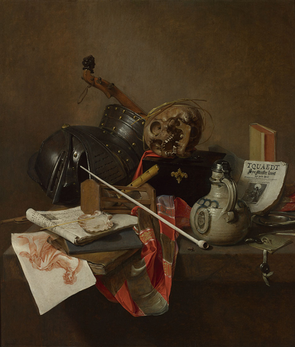Our first painting is Jan Treck's Vanitas Still Life. If you follow the link to the National Gallery website and "zoom-in” on this painting, you will find so many amazing details. I’ll mention just one detail here, and leave the rest for you to discover and reflect upon. If you look at the ceramic flask on the right-hand side, (it is actually a beer jug), you will see the artist’s signature, and the year 1648. This was an extraordinary year in the country in which this painting was made. The Netherlands had been recognised as a fully independent Republic in that year. Part of the identity in this new country was their newly Reformed church, and their new art, did not depict religious figures, but instead, Dutch artists depicted scenes of everyday life, portraits, interiors, landscapes, simple objects, and each one was painted with the same loving devotion as an altarpiece, and, like those great works in chapels and churches, paintings like Jan Treck’s Vanitas Still Life were full of symbolism and latent meaning.
Marc Woodhead,Educator at the National Gallery
Marc Woodhead,Educator at the National Gallery
|
Wednesday 26th February
If there is one thing we must all confront, and which we all desperately avoid, it is death. We pad against it with jokes, cushion ourselves with property, and mourn a little for our own mortality with each bereavement. Vanitas paintings — from the Latin translation for the Biblical Hebrew hevel (meaning: nothing, vapor, vanity, etc.) in Ecclesiastes — was a dark satire on a fashionable still life of the Dutch Golden Age. Nouveau riche Dutch patrons often commission still lifes showcasing their wealth. Jan-Jansz Treck's Vanitas confronts us with a post-mortem of our property, showing them mere objects we borrow. It faces us with our own death; it invites us to learn how to die. As Christians, we ask, how do we entrust our end to God, who also gifted us our beginning. Calvyn du Toit, Musician & Theologian, Holy Trinity Thursday 27th February On looking at this piece with no knowledge of its origins or meaning, we were struck by the scene of chaos. As some of you may know already, this is unique for still life paintings which normally depict a sense of serenity. When we looked closer, we noticed several items of opulence - jug of wine, silk scarf, jewellery box - immersed between rather more ominous looking objects, eg. a skull, a knight’s helmet etc. When thinking about how this painting may link to Lent, we thought how Jesus denied himself of all things (opulent or otherwise) during the 40 days and 40 nights but was tempted several times by the devil and yet still he resisted. The haphazard layout of the table reminded us of the chaos that ensued just before his crucifixion. If you look closely, you can also see the skull with a crown of twigs... Once we investigated the actual meaning of the piece, which is that nothing lasts forever yet the arts remain, it gave our interpretation further gravitas. You can have all the luxuries in the world, yet these are just as likely to bring chaos to your life. The one remaining constant for us all is Christ. Amanda, Seb and Archie Kershen Zumba Teacher, Members of St Stephen’s and Junior Church |
Friday 28th February
I have always loved how I am simultaneously drawn to and repulsed by Dutch Vanitas paintings. These works, defined by symbols representing the transience of life, are vehicles through which the viewer can contemplate their own mortality. The fleeting nature of earthly achievements and pleasures is conveyed through the depiction of representative objects, often arrayed in a seemingly haphazard manner to emphasize decline and decay. In this work by Jan Jansz. Treck (1605/6-1652), the artist includes images that allude to learning and art (books and drawing), music (instruments and score), power and war (helmet), riches (treasure box and fabric), pleasures (clay pipe and wine jug), baptism (scallop shell), as well as symbols of the passage of time (hour glass), and death (skull). The painting is particularly evocative through subtle touches such as the dying ember near the clay pipe and the palm “crown” surrounding the skull. During the Lenten period of reflection and contemplation, I find the gruesome beauty of Vanitas paintings provides a unique focus for meditating on the ephemeral nature of worldly goods and pursuits. Suzanne Julig, Art Advisor & Educator, Holy Trinity Saturday 29th February The most striking image in this painting, which immediately leaps out at the viewer, is surely the skull which surmounts everything else. The rest of the objects represent either earthly pursuits, passions and pleasures – the lute, the sheet music, the lavish cloth, the flagon of wine, a flute – or earthly glory – the helmet. But above all else sits the skull, placed in the same position as the helmet. This painting is an unmistakeable memento mori – a reminder of our mortality. The skull sits just above an hourglass, measuring the span of our lives. Something about the straw or twine curled around the cranium suggests a crown for Mors Triumphator. Death is supreme sovereign, his power irresistible. All earthly joys and pleasures are vain and fleeting. Our first instinct might be to see this as a bit negative, depressing and dreary, but I don’t think it is. As with all memento mori, the idea here is not to cripple us with anxiety about fear of our own death, but to confront it and consider what it is really important. Reflecting on the certainty that we will at some point die, the natural next step is to think about what we want to achieve by then. What will be important to us as we look back on our lives and what do we want to leave behind? Duncan Hegan, Tea@3 Helper and Pastoral Assistant at St Matthew’s Church |
Location |
|

